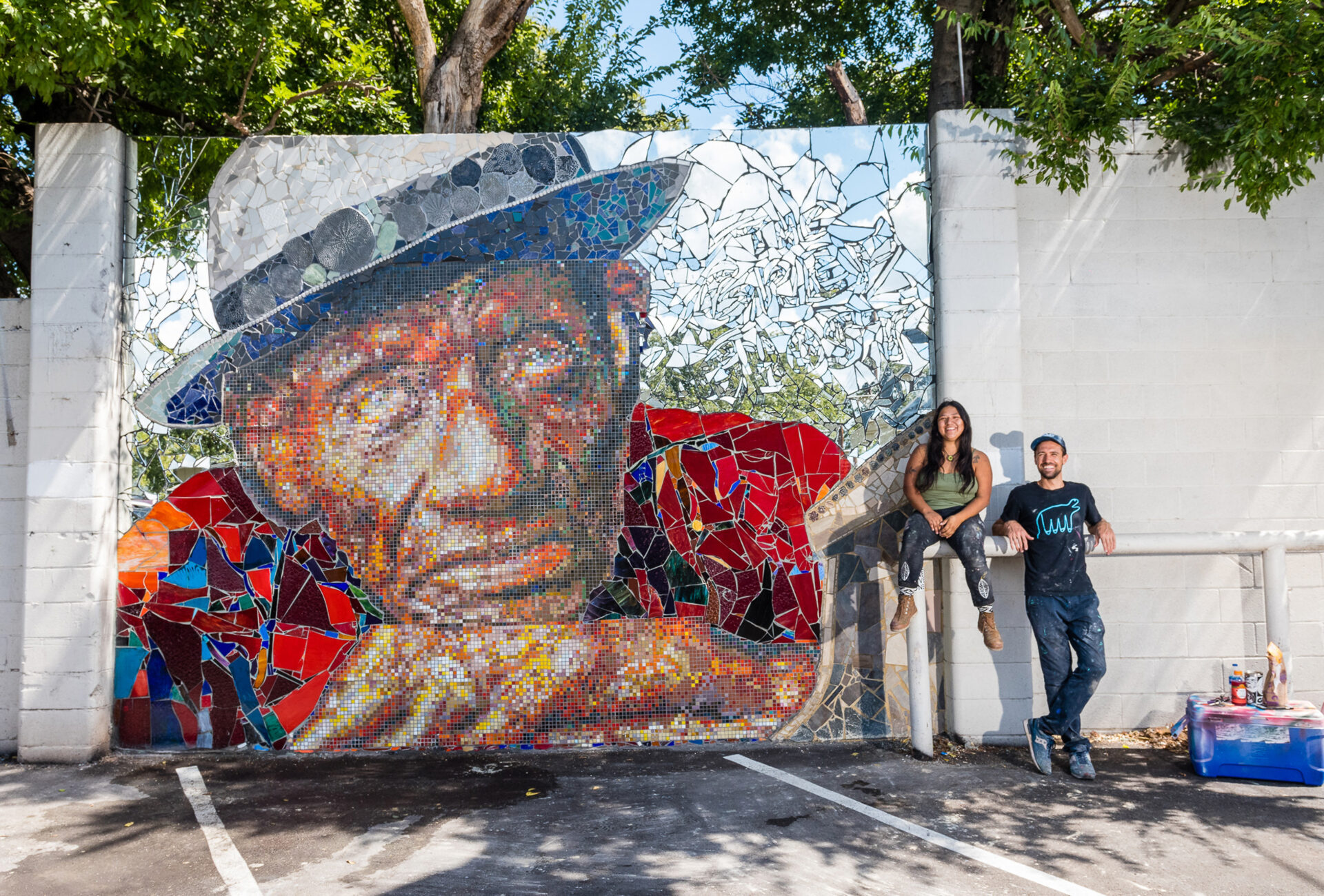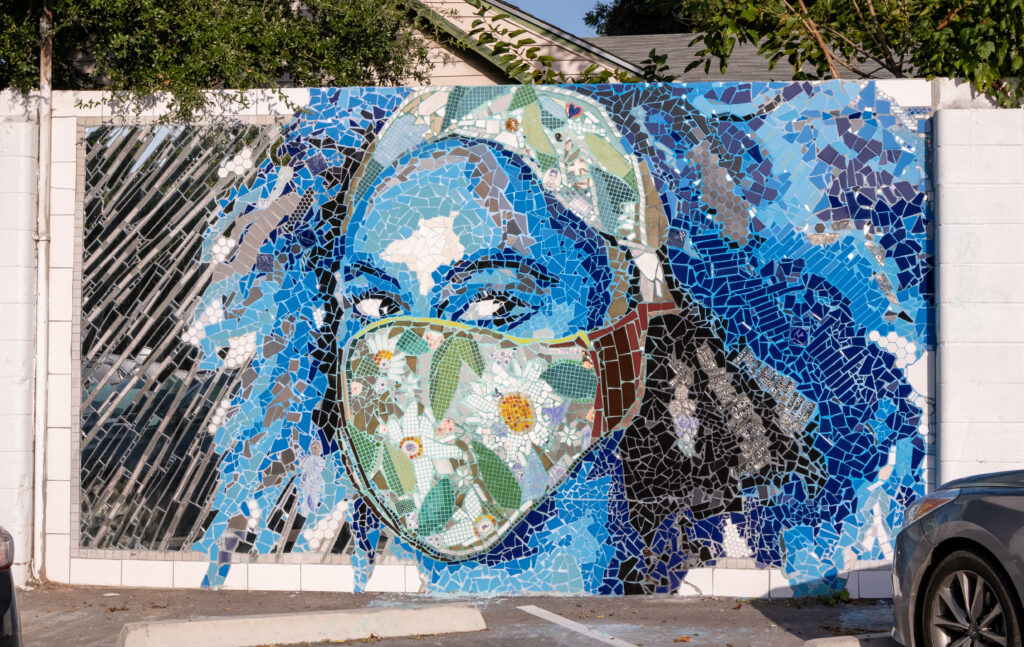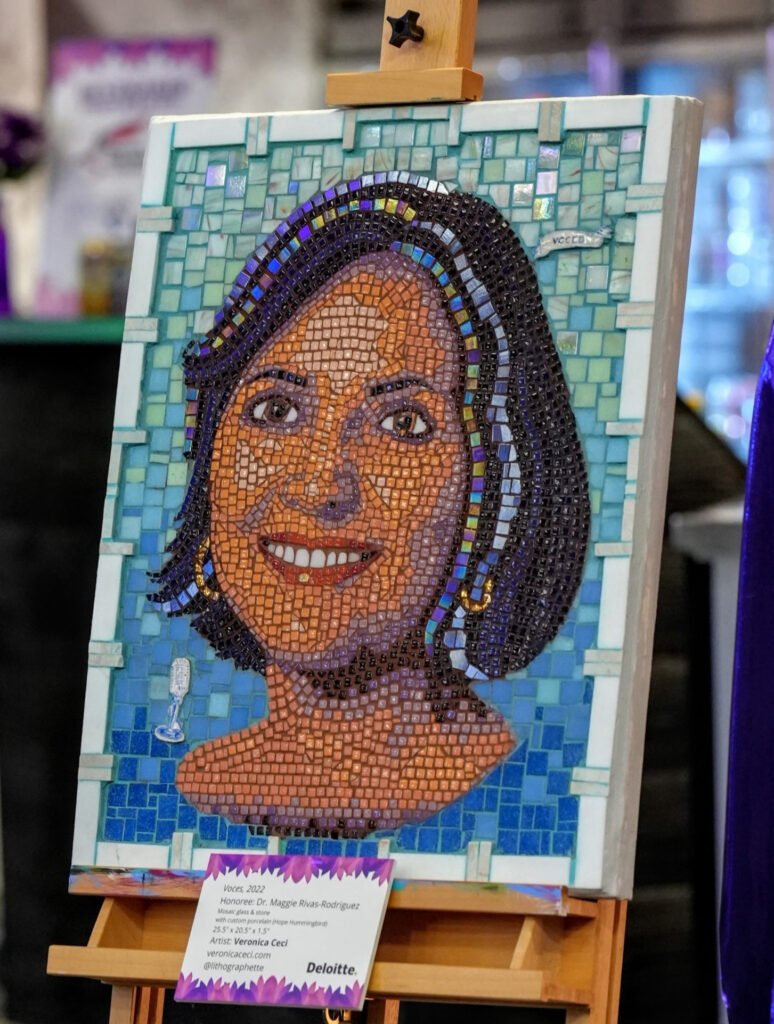A Wanderer Puts Down Roots and Grows Community
J Muzacz graduated from UT in 2006. Since then, he’s made a career — and a 700-page book — out of practicing and chronicling graffiti, street art, murals, and mosaics in Austin.
Armed with crates full of spray cans, the clothes in his backpack, and a $600 car he bought from his co-worker at the smoothie shop, J Muzacz left Houston for good in 2002 to attend The University of Texas at Austin.
I first met J in 2004, a new transplant to Austin myself. Fresh off the art-history-major boat, I was curating art shows at a downtown coffee shop when Sloke One, one of the godfathers of the Austin graffiti and public mural scene, brought in a graffiti show. Full of giant, brightly colored paintings featuring tag names and fantasy characters, it sold faster than anything we had hung before. Muzacz’s paintings were among those featured, and I bought a small piece of his of a shark; it now hangs on the wall outside my son’s room. Almost 20 years later, when Muzacz sent an alumni news update to COLA headquarters, I remembered him — and his art — immediately. Austin still feels small, sometimes.
Muzacz sort of stumbled upon the liberal arts. As a junior, he realized he was ahead on credits and hadn’t yet picked a major. He had enjoyed his sociology classes, so he went with it.
“I remember professor Lester Kurtz had an impact on me. He taught courses like ‘Deviance in Society,’ ‘Blues History,’ and ‘World Religion,’” Muzacz says. “All things considered, sociology was a good fit. Art was always fun, but it took me a while to figure out it could become my career and a way of life.”
Muzacz had always made art on the side as a kid, but it took him a while to realize how much energy it could elicit from its viewers. He was visiting Austin during high school and saw spray paint artist Carey Huckaby performing space paintings in front of an enthusiastic crowd on Sixth Street. Taken with the show, Muzacz went home and practiced his own space paintings. A couple of years later, as a sophomore at UT, Muzacz brought Huckaby a painting he made and asked him if he could work with him.
“He said no,” said Muzacz, “but finally after a few more tries, he let me help out on the weekends. That was the first time I sold my art. I was selling paintings for like $25 bucks, and one night I made around $400. It felt like drug money; I couldn’t believe it.”
One night, Huckaby and Muzacz had a big crowd and decided to have an art battle. They agreed that they would choose the winner based on the cheering of the crowd and that they would burn the painting of whoever lost.
“I swear, the crowd cheered louder for my painting, but Carey grabbed it, lit it on fire, and then fired me. I think that’s when I first realized I might have some talent.”
Not wanting to be hemmed in by poster size or subject matter, and still working toward his degree, Muzacz went back to doing graffiti on walls, and without a crowd. He soon realized, however, that he wanted his work to have a more meaningful impact. He asked Monarch Food Mart on East 38 ½ street if he could paint their wall with the life cycle of a butterfly for the cost of the paint, and they agreed (it’s still there).
“Little by little, I really fell in love with doing work for the people,” said Muzacz.
After college, Muzacz spent a few years traveling in Asia and Europe, and then couch surfing in Austin, doing his best to live off the grid and subsisting on exchange work and gardening. Through the city-sponsored program Totally Cool Totally Art, he got a part-time gig teaching urban painting and street art to at-risk teenagers at rec centers around Austin. “The kids would hang around after school at the rec centers and they’d see us come in and a light would go on. ‘Yo! You have spray paint?!’ All of a sudden there would be 30 kids in the class.”
That job, says Muzacz, ended up setting the trajectory for his next 15 years. “That job really put me in a community mural mindset,” he said, “because it wasn’t just one artist doing a piece, it was 20 kids in the community doing it together.”
In the graffiti world, where so much of the work is driven by pushing one’s own name, literally, Muzacz’s brand of community-centered work is a bit of an outlier. But despite graffiti’s sometimes egotistical agenda, it does offer a community of mutual support and skill sharing, and Muzacz continues to learn from his strong ties to other graffiti artists in town. Buoyed by that support, and as his own practice evolved, Muzacz grew his mission and his ability to connect with people.
“When I think about my work, it’s not necessarily about what I paint, but who I paint for, and whether my work will benefit them,” Muzacz says. “My academic background gave me so many of the soft skills I needed to go into a group of people as an outsider and be able to communicate effectively and be empathetic to their needs and histories and culture, so that my work is responsive to and resonates with them. That’s my real barometer of success.”
Today, Muzacz runs The Mosaic Workshop with co-founder Carmen Rangel and frequent collaborators Lolita Rodriguez, Hope Hummingbird, and many others. They host free and low-cost workshops in mosaic making and they install the work in, for, and with the Austin communities they work in. Their space in East Austin, Something Cool Studios, is bursting with color and materials, as well as with the work of their friends and students. When I visited to conduct our interview, I was sucked in immediately by the positive, collective energy of the place.
The Workshop collaborates with long-established non-profits — including Poder, Latinitas, American Youthworks, Raasin in the Sun, and the Mexican American Cultural Center — which expands their reach. Their Portraits series can be seen all over town. Another Mosaic Workshop project, Legends, specifically honors female leaders of color who have impacted Austin, and commissions female artists of color to make the artworks.
“We’re here to facilitate and connect creatives with valuable opportunities that are paid and that showcase the vibrant diversity of our city,” says Muzacz. “We want people to feel represented and validated. People just have to learn the simple mosaic method and then can make it their own. We’ve had art students go on to get six-figure commissions in prominent public places. We are helping change people’s lives and careers through art making — ripple effects.”
The Workshop operates with a strong belief that its work should be responsive, inclusive, representative, and add value, and that the people who do the work should be learning and making relationships. While most public artists practice some form of community engagement, Muzacz and his team feel unique in offering a process for people to both come up with the concept for the work and help make the work itself.
“The real gem in the process for me is when you have random people sitting at a table making mosaics together; you’re bridging socioeconomic and generational gaps, and unique connections happen,” he says. “You’re having a shared experience, and a mosaic is a permanent medium that holds that.”
Muzacz calls the life he helps bring to neighborhood spaces with these mosaics “placekeeping,” citing the knowledge and culture that old Austin communities have developed over generations, and their efforts to keep that knowledge and culture alive. And while there is an ever-more popular narrative among Austinites that the city has changed too much, that old Austin doesn’t exist anymore, Muzacz feels sure that it does: “It just moves around a bit now,” he says, “and you might have to look a little deeper to find it.”
In getting to know so many old Austin communities, Muzacz has gone from something of a drifter to a community pillar — and an expert on the history of graffiti, street art, murals, and mosaics in Austin. He has even published a 700-page anthology chronicling it all, ATX Urban Art. He says he was able to make the book with such depth due in part to the research and writing skills he gained at UT, and because he knows so many of the people featured as colleagues and friends.
“Austin is the first place I really felt like I was connected to the community and a useful member of society contributing something of value,” Muzacz says. “As a traveler my whole life, a grandson of immigrants, what are my roots, really? We’re just seeds flying in the wind, and where we land is where we plant and grow. So, I landed here and planted some roots.”



